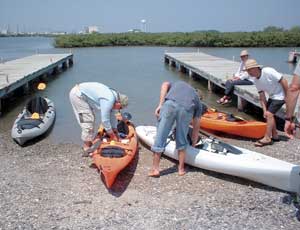
Follow this guide to put limits of redfish in the boat all spring long.
President Bush, in his recent State of the Union Address, called upon Americans to help reduce our dependence on foreign oil.
One group is already doing their part. By fishing from paddle-powered watercraft, members of the Bayou Coast Kayak Fishing Club are just saying ‘no’ to fossil fuel.
The sport of paddlecraft fishing, a.k.a. “puddling,” remains the hottest segment of the outdoor industry. In fact, when the number of participants on the “Cajun Country Kayak Forum” reached critical mass last year, many members of that forum decided it was time to form a club. Response was overwhelming, and BCKFC was born.
While the old forum at kayakfishingstuff.com continues to be popular with members and non-members, the club’s new website has its own forum, great how-to articles and even private-member access to fishing locations and trip reports. Check it out at www.bckfc.org.
Even prior to the club’s existence, members of the Cajun Country Forum held an annual saltwater tournament that generated interest from West Texas to South Florida.
In great Louisiana tradition, it was more than just a contest; it was an excuse to have a party. Participants enjoyed Cajun cuisine while sharing experiences and even testing out various paddlecraft. They called this event Paddlepalooza.
Like most tournaments, the entry fees go back into prizes for the winners. Nothing to compare to most weekend bass tournaments, but folks do compete hard for bragging rights.
Organizers took a page from the CCA STAR tournament, and decided it was more fun to have a contest where not just the biggest fish always won, but where anyone of any skill had a chance to win.
For the fourth-annual Paddlepalooza coming up on March 17, the grand prize — a kayak courtesy of Backpacker of Baton Rouge — will go to whoever catches the redfish with the most spots.
Tournament entry fees are $40 for members and $50 for non-members. Participants can fish with lures or flies, but bait is not allowed. (Just say ‘no’ to bait also.)
Too much wind and dirty water, and my unwillingness to use anything other than flies, cost me any chance of victory at one of the early events I competed in. Still, it turned out to be a very rewarding experience.
It was from this event that I learned much about rigging up sit-on-top (SOT) kayaks. Let’s just say that if this sport continues to grow, you might be wise to invest in companies that manufacture milk crates, pool noodles and PVC pipe.
Having been predominantly a sit-inside kayak (SINK) and canoe fisherman for many years, I finally felt comfortable enough to take the plunge and buy a SOT.
Don’t get me wrong, choosing a SOT doesn’t mean they’re better than SINKs or canoes. Cormier’s 1st Law of Puddling still applies: Selecting a paddlecraft for fishing is an exercise in compromise. In other words, everything is a trade-off.
In addition to the pros and cons for canoes versus SOTs versus SINKs, also within each type one must argue: longer (faster, harder to handle) versus shorter (easy to handle, less weight, harder to track), wide (stable, slower) versus narrow (faster, less stable), composite (light but vunerable) versus polyethylene (heavy but tough), and so on.
Choosing a paddle-powered vessel involves several factors.
One factor is the type of fishing you do. For instance, when out with one of my kids or a friend, we use my Old Town 147 Guide canoe. Canoes are better for multiple passengers.
This particular model is also so stable, that when marsh fishing, I often stand up in the rear and push pole, while sighting for reds in shallow water.
When fishing alone, my Ocean Kayak Caper SOT is easy to control in the wind and light enough to carry to obscure launch spots. It’s not nearly as fast as one friend’s Tarpon 140 SOT, nor does it track as well as another friend’s Pungo 120 SINK, but it’s my personal compromise of manuverability, very light weight and great stability.
Another factor is how the boat fits you. If you’ve had back problems, then a yak may not be your best option. Unlike recreational paddling, fishing is a prolonged sport. Sitting for several hours, with legs perpendicular to your torso, can exert a great deal of fatigue on your back. Try sitting down on the floor with your back up against a sofa for a few hours, and see how it feels afterwards. If when you stand up, your back is sore for an extended time, then a solo canoe might be a better option.
A third factor is the type of water you’ll be fishing. Canoes and SINKs are great choices for freshwater anglers, or even the interior marshes.
If you plan to go into big water, or even the Gulf, then SOTs are a much safer choice. Think of them like plastic bottles: Water just goes over and out, and unless there’s a crack, they keep on floating. (I know some puddlers who stuff their SOTs with pool noodles just in case a crack does develop.)
Bottom line: If you’re interested in getting into puddling, you really should test paddle all kinds of boats first.
There are several venues for trying out boats. Most paddlecraft outfitters like Backpacker hold “Demo Days” on a Saturday morning or Sunday afternoon on a nearby lake.
In addition to the Bayou Coast club, there are general paddling clubs around the state that occasionally host demonstrations. Even some fly fishing events, like the Red Stick Fly Fishers Conclave (March 3) and the Federation of Fly Fishers Gulf Coast Expo (May 18-19), feature these as well.
For the dates, locations and times of these events around the state, and elsewhere on the Gulf Coast, check out bckfc.org, gulfcoastkayakfishing.com, kayakfishingstuff.com, laflyfish.com and paddling.net.


